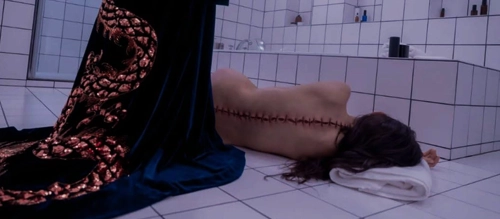
The Substance (2024)
Director: Coralie Fargeat
Screenwriter: Coralie Fargeat
Starring: Demi Moore, Margaret Qualley, Dennis Quaid
In Jack Halberstam’s “Skin Shows: Gothic Horror and the Technology of Monsters,” the author writes that Mary Shelley’s “Frankenstein,” “suggests that it is people (or at least bodies) who people fear, not ghosts or Gods, devils or monks, windswept castles or labyrinthine monasteries.” Perhaps no body is more frightening than our own, as we struggle against the inevitability of time or disease, pinching and squeezing and plucking and cutting our way to a more perfect self. We fill our faces with Botox and fillers; we starve our bodies or binge and purge. If we let ourselves age, we’re called old and washed up. If we try to stall that process with cosmetic surgery, we’re accused of ruining our looks. For women especially, it is a losing battle. And the violence we inflict is in vain: no matter what we do, we can’t escape from who we are or the limits of our own bodies.
This kind of internalized self-loathing manifests literally in French filmmaker Coralie Fargeat’s sophomore outing The Substance, a gnarly body horror spectacle that confronts the way society, more specifically Hollywood, mistreats and discards women after they’ve lost their supposed youth and beauty. Satirical and grotesque, The Substance is sensory overload in the best way, with some of the year’s best special effects and sound design.
In The Substance, Fargeat’s follow-up to her 2017 exploitation film, Revenge, TV exercise host Elisabeth Sparkles (Demi Moore) is desperate to regain relevancy after being fired on her 50th birthday by the show’s producer, Harvey (Dennis Quaid). Distracted by her billboard being torn down and replaced, Elisabeth then gets into a car accident and is sent to the hospital, where she meets a mysterious and beautiful young nurse (Robin Greer) who offers her the chance to change her life. Elisabeth is introduced to a black-market drug called The Substance, a lime green serum that, when injected, will create a younger, more perfect version of herself. Though she hesitates at first, Elisabeth takes the drug, her iris splitting in two like an atom.
This new version, birthed from a slit in Elisabeth’s back, calls herself Sue (Margaret Qualley). Sue must inject a stabilizer into her body every day using spinal fluid from Elisabeth. The two must switch bodies every seven days, without exception. While one is out living her life, the other lies unconscious. The rules are simple: whatever happens to one body, happens to the other. Though Sue manages to go out and get Elisabeth’s old job, her fame quickly grows and she becomes increasingly disgusted with the thought of returning to Elisabeth’s old, tired body. Elisabeth also changes – becoming restless and withdrawn, drowning her loneliness in food and alcohol, her jealously of Sue festering. It isn’t long before this self-hatred begins to consume her.
The Substance is not subtle and that is by design. It’s a film that operates on the surface of things, its characters and setting emblematic of a self-consuming hunger to be seen as desired and beautiful. Fargeat and cinematographer Benjamin Kracun, who also shot Emerald Fennel’s Promising Young Woman, use central framing throughout most of the film, as well as fisheye lenses, to create a sense of distortion and unease. The desolate, soulless version of L.A. that Elisabeth inhabits is sparse and menacing. Even the palm trees seem to loom threateningly overhead. There is nothing in this world outside of Eisabeth’s own self-loathing. She exists in a liminal space, at the threshold of transformation, and the film does a great job of visualizing this with neverending hallways and white tiled bathrooms. Her insecurities are further magnified as Fargeat focuses her camera on titillating close ups of Qualley’s ass and thighs in pink spandex as she thrusts her hips while dancing on her exercise show, much to the mouth-frothing pleasure of Harvey. This eroticism is exaggerated and heavy-handed as Fargeat attempts to show the shallowness of the Hollywood machine.

The Substance goes all in on its special effects and is a worthy entry into the body horror genre. Unsettling and grotesque, the film succeeds in making literal the dysmorphic way we are taught to view our bodies. But this simplicity of spectacle doesn’t always give us much to think about and, more often than not, ends up having the opposite effect, much like it does in Fargeat’s previous film, Revenge. On a purely visual and auditory level, Revenge is a well-crafted film, but it is let down by a script that doesn’t bother to really get to know its characters. Sure, Fargeat emulates the hyper sexualization and violence of exploitation films beautifully, but she doesn’t appear to have much to say about them.
The same can be argued for The Substance. Yes, the male gaze frames women as objects of desire, but what happens when the object looks back? Fargeat doesn’t allow her characters the chance to explore this, which leaves both Sue and Elisabeth running in place for most of the film. By the end of the second act, we’re no closer to understanding either character than we were at the start. There’s no real connection between the two selves, either. It would be fair to interpret this as Elisabeth’s inability to recognize herself in Sue and Sue’s disgust with her older body, leaving her desperate to separate herself entirely from a vessel she sees as worthless and imperfect. But Fargeat makes no attempt to examine her characters closer than that, to dig deep and give us a reason why Elisabeth is clinging to her fame and youth so violently. There’s something missing at the heart of The Substance.
Demi Moore’s casting at least gives the film a metatexual layer worth exploring. A former member of the iconic 80s Brat Pack, Moore is painfully familar with how isolating and brutal being in the public eye can be. Over the years, the Ghost actress has survived severe scrutiny over her looks, her relationships, and her career choices. In 2021, she faced intense backlash after walking the catwalk at Haute Couture Fashion Week in Paris, sparking rumors that she had undergone plastic surgery. Now 58, Moore’s fraught relationship with the media over the course of her career lends itself well to The Substance. But her performance alone is captivating enough. While the film itself is anything but subtle, Moore’s performance is mostly grounded and nuanced.
One of highlights of the film comes when Elisabeth is getting ready to go out on a date and keeps running back to look in the mirror. She fixes her dress, adjusts her makeup. But still, she can’t escape from Sue, who lies naked and perfect just a few feet away. Her sadness and anger is palpable and searing as she finally breaks and begins to claw at her face. Despite Moore’s ability to get us to care about Elisabeth, the film itself is almost cruel and indifferent towards her. It is obvious Elisabeth’s transformation is a manifestation of the way she views herself and her fears of getting older. But Fargeat isn’t interested in examining the root cause of that fear and, instead, opts to use Elisabeth’s disordered eating as fodder for the grotesque without ever looking inward.
Spearheaded by a career-best performance from its star, The Substance is certainly a feast for the eyes and ears, but its narrative inconsistencies make it difficult to parse exactly what the film is trying to say about the complex and messy relationship women have with their bodies.
Score: 21/24

